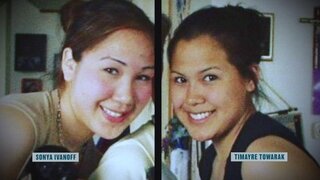Create a free profile to get unlimited access to exclusive videos, breaking news, sweepstakes, and more!
Investigation Into Alaskan Teen's Murder Reveals Shocking Killer: "Evil Comes in Different Forms"
“Clues at the crime scene seemed to point in one direction. The twist that came next was one this town would never forget," Dateline Correspondent Josh Mankiewicz said of the shocking murder of Sonya Ivanoff.
Sonya Ivanoff was just 19-years-old when she disappeared on a rainy early morning walk around 1 a.m. on Aug. 11, 2003 in the small city of Nome, Alaska.
The next day her naked body was discovered along a remote road just outside of town. She had been shot once in the back of the head and was covered in bruises.
“I think I just dropped. I just couldn’t believe it,” her roommate and best friend Timayre Towarak told Oxygen’s Dateline: Unforgettable of learning the tragic news.
Her murder — also highlighted in Oxygen's Fatal Frontier: Evil in Alaska — would launch a local and state investigation and uncover a shocking killer that stunned the community.
For more Dateline:
Illinois Father Is Shot Dead When Picking Up Daughter From Ex-Wife's "Clannish" Family
Clues Revealed for First Time in Murder of 27-Year-Old Singer Found Tied Up in Her Home
The Shocking Murder of NBA Star Lorenzen Wright: "Ultimate Evil"
“I’ve covered stories in a lot of small towns, this case took me a place more remote than anywhere I’d ever been,” Correspondent Josh Mankiewicz shared. “Clues at the crime scene seemed to point in one direction. The twist that came next was one this town would never forget.”
Who was Sonya Ivanoff?
Ivanoff moved to Nome from the small Alaskan village of Unalakleet, where she grew up, after graduating high school in 2002.
The outgoing teen found work at an admitting desk at a local hospital and soon her best friend Towarak moved to the city of 3,800 people to join her. The friends lived together and because they didn’t have a car of their own, they walked everywhere they went.
“We felt safe walking in Nome,” Towarak recalled. “It felt like home too.”
Sonya Ivanoff Goes Missing
On the night of Aug. 10, 2003, the roommates were hanging out at a home with friends and playing board games. Both girls left around 1 a.m. Towarak had to work early the next morning and decided to crash at a friend’s house nearby, while Ivanoff — who had the next day off from work — wanted to stay out longer.
“When we parted ways I walked toward my friend’s house and she continued walking down the street, but it was toward our house area,” Towarak remembered. “ We always had this saying, ‘peace out, pal.’ We did that and she jumped in the rain and started walking.”
It would be the last time she ever saw her friend alive.
When Towarak got home early the next morning to get ready for work, she was surprised to learn Ivanoff never made it home.
She thought maybe Ivanoff had just decided to stay at a friend’s house, and since it was before the era when cell phones became commonplace, she went to work without too much concern. But when Ivanoff still wasn’t home later that evening, Towarak reported her missing to the Nome Police Department.
“I think I was hysterically crying just because I was so scared,” she said of walking into the department that night. “They kind of took it like it was a joke or something.”
But when Ivanoff failed to show up to work the next day, her boss also called police and a search was launched for the missing teenager.
Around 8:30 p.m. on Aug. 12, 2003, a volunteer firefighter followed some fresh tire tracks down a rarely used road and discovered Ivanoff’s naked body.
State investigators were called in to handle the case, but it would take time for the team to get to the crime scene. While they waited, Nome P.D. covered the whole area in tarps and took shifts guarding the site.
“Many times in cases that I had to respond to as well as other troopers, the first 24 or 48 hours might just be getting to the scene,” Trooper investigator Eric Burroughs explained. “It’s called the Alaska frontier state for a lot of reasons. It’s not, it’s not like uh, the big city at all.”
When the team finally did get to the site, they found Ivanoff laying near a pool of blood. A vehicle had driven through the blood, leaving distinct tire tracks. One of the treads was different, suggesting the vehicle had mismatched tires. Authorities also found a smear of light blue paint on some nearby foliage. The killer had also seemingly taken Ivanoff’s clothes, leaving her with only one sock.
The Evidence
Although Towarak insisted Ivanoff had “no enemies,” investigators began by taking a close look at those who knew the teen, including a male friend who went by the nickname “Koonuk.”
Koonuk drove a blue truck with mismatched tires. Even more concerning, authorities discovered blood inside his truck and more dried blood on a tarp and on the butt of a rifle kept inside the vehicle.
But Koonuk claimed he hadn’t talked to Invanoff in “almost two weeks.” On the night she was killed, he said he was 70 miles away hunting with friends. Investigators were officially able to rule him out after the blood was determined to belong to an animal and the tires did not match with the impressions left at the scene.
Investigators ultimately learned that the tire marks had been made by an unsuspecting couple who had pulled into the road without ever noticing the body.
That left investigators with few clues to go on. It wasn’t until a Nome Police officer working the case on the night shift discovered a tip in the case file that was never followed up on that investigators got the break they needed.
A woman named Florence Habros told the officer that she had been out smoking on her porch with her sister around 1:26 a.m. when she saw Ivanoff walk by. Habros saw a Nome Police SUV pull up alongside Ivanoff. After Ivanoff talked with the driver for a minute, she got into the passenger side of the vehicle and the SUV drove off.
What happened to Sonya Ivanoff?
There were only two police officers who had been on duty that night, Stan Piscoya and Matthew Owens.
Just before both officers were scheduled to fly to Anchorage to give statements to investigators, Cruiser 321 — one of just three vehicles shared by the whole police department — disappeared.
Owens said he found the vehicle at Bessie Pit, not far from the crime scene, and that someone got out of the vehicle, opened fire, and ran off into the tundra. An ominous note, addressed to “pigs,” was left behind in the SUV along with one of Ivanoff’s ID cards to prove his connection to the case.
"I hate cops. I hate everyone of you. Sonya was just a person in the wrong place at the wrong time. I do not know her. As you can see it was easy for me to take your pig car keys right there. It was not her fault. She thought I was a pig and sh-t just happened,” the note said, according to court documents.
"Everyone of you should be more careful. I watch every move you make,” the author threatened. “You leave me alone and I will leave you alone. I will also shoot you in the head if you get close.”
While it was possible someone could have gained access to the SUV, Burroughs didn’t believe Invanoff would have gotten into the vehicle unless it was an officer she recognized from the small town.
He believed the note had likely been written by one of the officers in an attempt to mislead investigators.
Although both officers claimed they had nothing to do with Ivanoff’s death, the investigation revealed that Owens was known to pick up civilians — especially women — during his shifts. He was also unaccounted for during a window of time that morning and failed a lie detector test.
In addition, Burroughs didn’t believe his story about finding the stolen SUV and seeing a man run off into the tundra.
Owens was fired from the police department and arrested. Several days after the arrest, other Native Alaskan women started to come forward claiming Owens picked them up in his SUV and sexually assaulted them, threatening one that no one would ever believe her.
Owens’ ex-wife also told police that he called her and said he needed her to take their son because Ivanoff had gone missing and he had to head into work, but this was before the teen was even reported missing.
Hoping to strengthen the case against him, Burroughs went to a hunting camp called Coffee Creek about 70 miles outside Nome that Owens was known to frequent. In one of the burn pits they discovered an eyelet to a shoe that was the same brand Ivanoff had been wearing that night. They also found a charred button from the brand of jeans she wore.
They believed Owens took a gun from the evidence room to pull off the killing and then returned it, although they could never definitively prove it was the same weapon used to kill her.
In a contentious first trial, the judge declared a mistrial after the jurors were unable to reach a verdict; however, Owens was convicted of first-degree murder in a second trial.
Her family is still haunted by the fact that she was killed by someone entrusted to protect her.
“Evil comes in different forms, you always gotta watch out,” her brother-in-law Tom Mostoller warned.



































